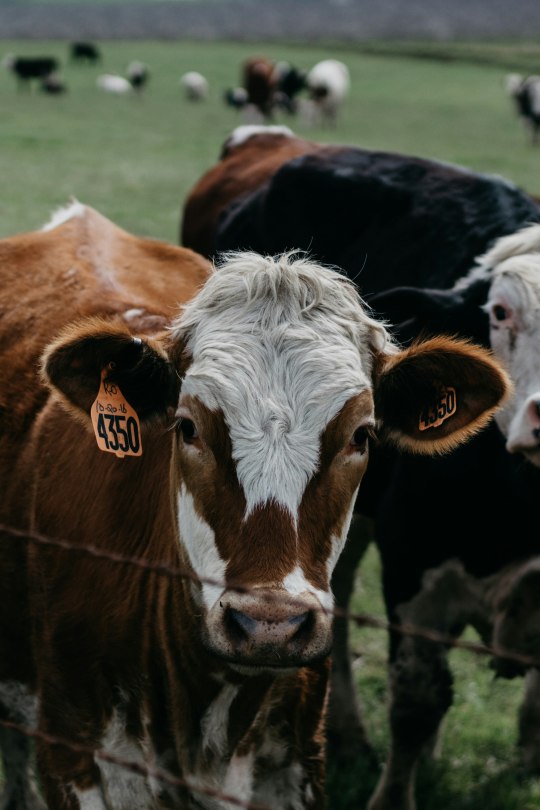#agricultural lands
Explore tagged Tumblr posts
Text
Started the day by reading this article from the NY times, and I'm frankly, disturbed.
Some highlights:
"For decades, farmers across America have been encouraged by the federal government to spread municipal sewage on millions of acres of farmland as fertilizer. It was rich in nutrients, and it helped keep the sludge out of landfills."
Which I knew, and I knew that there were concerns about contaminants from like, the medications people were on. But human waste is part of the nutrient cycle, and it always made sense to me that it should be throughly composted and returned to agricultural lands, and I assumed that people in general were taking the steps necessary to make it safe.
But here's what I didn't know:
"The 1972 Clean Water Act had required industrial plants to start sending their wastewater to treatment plants instead of releasing it into rivers and streams, which was a win for the environment but also produced vast new quantities of sludge that had to go somewhere."
Which, yay, no longer polluting bodies of water, but now that means we're applying industrial waste water to agricultural lands. And have been since 1972. Which leads to this situation, among many others, I'm sure:
"The sludge that allegedly contaminated the Colemans’ farm came from the City of Fort Worth water district, which treats sewage from more than 1.2 million people, city records show. Its facility also accepts effluent from industries including aerospace, defense, oil and gas, and auto manufacturing. Synagro takes the sludge and treats it (though not for PFAS, as it’s not required by law) then distributes it as fertilizer."
So here's what some states are doing:
"In Michigan, among the first states to investigate the chemicals in sludge fertilizer, officials shut down one farm where tests found particularly high concentrations in the soil and in cattle that grazed on the land. This year, the state prohibited the property from ever again being used for agriculture. Michigan hasn’t conducted widespread testing at other farms, partly out of concern for the economic effects on its agriculture industry.
In 2022, Maine banned the use of sewage sludge on agricultural fields. It was the first state to do so and is the only state to systematically test farms for the chemicals. Investigators have found contamination on at least 68 of the more than 100 farms checked so far, with some 1,000 sites still to be tested.
“Investigating PFAS is like opening Pandora’s box,” said Nancy McBrady, deputy commissioner of Maine’s Department of Agriculture."
This is fun:
"The E.P.A. is currently studying the risks posed by PFAS in sludge fertilizer (which the industry calls biosolids) to determine if new rules are necessary.
The agency continues to promote its use on cropland, though elsewhere it has started to take action. In April, it ordered utilities to slash PFAS levels in drinking water to near zero and designated two types of the chemical as hazardous substances that must be cleaned up by polluters. The agency now says there is no safe level of PFAS for humans...
It’s difficult to know how much fertilizer sludge is used nationwide, and E.P.A. data is incomplete. The fertilizer industry says more than 2 million dry tons were used on 4.6 million acres of farmland in 2018. And it estimates that farmers have obtained permits to use sewage sludge on nearly 70 million acres, or about a fifth of all U.S. agricultural land."
There's more, but I wanted to condense it at least a little bit. I am glad we're raising awareness, and I'm glad we're starting to regular the amount in our drinking water, and I hope that we'll find a way to actually deal with PFAS. I am so frustrated that people are exposed in the first place, and in nigh inescapable ways.
Also, to all those people who were like, oh, organic isn't at all healthier for consumers? Guess what the organic standards don't allow to be applied?
140 notes
·
View notes
Text

Smart Investments | Diversify Your Portfolio BRC Smart Realty

0 notes
Text



Santana PS10 Anibal Pickup, 2007. Santana Motor of Linares, Jaén, Spain was established in 1954 by the Spanish government to supply farmers with mechanical equipment. In 1961 they began to build Land Rovers in Spain under license to the Rover Company in the UK. Thought the licensing agreement with Land Rover ended in 1990 Santana continued to build their own versions of the Land Rover Defender. The Anibal Pickup was unique to Santana, there was no equivalent Defender pickup. However competition in the 4X4 market is intense and Santana Motor was closed by its owner, the Regional Government of Andalusia, in 2011
#Santana#Santana Motor#Santana PS10 Anibal Pickup#Land Rover Defender#2007#4x4#pick-up#off road#dead brands#Spanish Motor Industry#Andalusia#agricultural vehicles
213 notes
·
View notes
Text
"In response to last year’s record-breaking heat due to El Niño and impacts from climate change, Indigenous Zenù farmers in Colombia are trying to revive the cultivation of traditional climate-resilient seeds and agroecology systems.
One traditional farming system combines farming with fishing: locals fish during the rainy season when water levels are high, and farm during the dry season on the fertile soils left by the receding water.
Locals and ecologists say conflicts over land with surrounding plantation owners, cattle ranchers and mines are also worsening the impacts of the climate crisis.
To protect their land, the Zenù reserve, which is today surrounded by monoculture plantations, was in 2005 declared the first Colombian territory free from GMOs.
...
In the Zenù reserve, issues with the weather, climate or soil are spread by word of mouth between farmers, or on La Positiva 103.0, a community agroecology radio station. And what’s been on every farmer’s mind is last year’s record-breaking heat and droughts. Both of these were charged by the twin impacts of climate change and a newly developing El Niño, a naturally occurring warmer period that last occurred here in 2016, say climate scientists.
Experts from Colombia’s Institute of Hydrology, Meteorology and Environmental Studies say the impacts of El Niño will be felt in Colombia until April 2024, adding to farmers’ concerns. Other scientists forecast June to August may be even hotter than 2023, and the next five years could be the hottest on record. On Jan. 24, President Gustavo Petro said he will declare wildfires a natural disaster, following an increase in forest fires that scientists attribute to the effects of El Niño.
In the face of these changes, Zenù farmers are trying to revive traditional agricultural practices like ancestral seed conservation and a unique agroecology system.
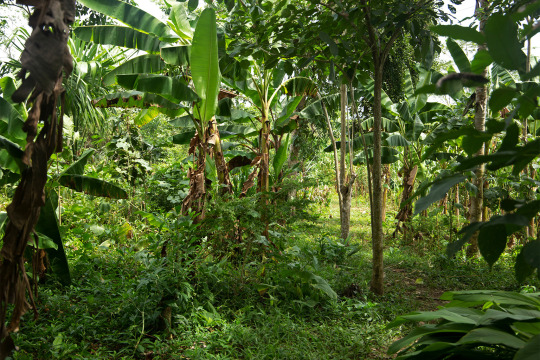
Pictured: Remberto Gil’s house is surrounded by an agroforestry system where turkeys and other animals graze under fruit trees such as maracuyá (Passiflora edulis), papaya (Carica papaya) and banana (Musa acuminata colla). Medicinal herbs like toronjil (Melissa officinalis) and tres bolas (Leonotis nepetifolia), and bushes like ají (Capsicum baccatum), yam and frijol diablito (beans) are part of the undergrowth. Image by Monica Pelliccia for Mongabay.
“Climate change is scary due to the possibility of food scarcity,” says Rodrigo Hernandez, a local authority with the Santa Isabel community. “Our ancestral seeds offer a solution as more resistant to climate change.”
Based on their experience, farmers say their ancestral seed varieties are more resistant to high temperatures compared to the imported varieties and cultivars they currently use. These ancestral varieties have adapted to the region’s ecosystem and require less water, they tell Mongabay. According to a report by local organization Grupo Semillas and development foundation SWISSAID, indigenous corn varieties like blaquito are more resistant to the heat, cariaco tolerates drought easily, and negrito is very resistant to high temperatures.
The Zenù diet still incorporates the traditional diversity of seeds, plant varieties and animals they consume, though they too are threatened by climate change: from fish recipes made from bocachico (Prochilodus magdalenae), and reptiles like the babilla or spectacled caiman (Caiman crocodilus), to different corn varieties to prepare arepas (cornmeal cakes), liquor, cheeses and soups.
“The most important challenge we have now is to save ancient species and involve new generations in ancestral practice,” says Sonia Rocha Marquez, a professor of social sciences at Sinù University in the city of Montería.
...[Despite] land scarcity, Negrete says communities are developing important projects to protect their traditional food systems. Farmers and seed custodians, like Gil, are working with the Association of Organic Agriculture and Livestock Producers (ASPROAL) and their Communitarian Seed House (Casa Comunitaria de Semillas Criollas y Nativas)...
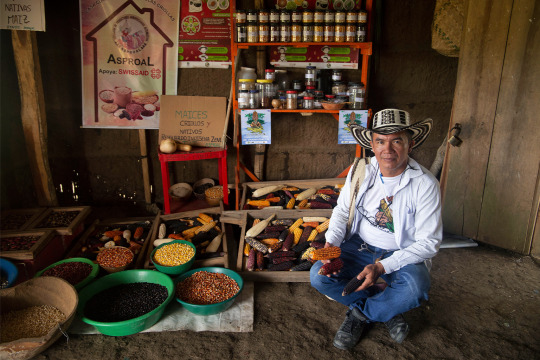
Pictured: Remberto Gil is a seed guardian and farmer who works at the Communitarian Seed House, where the ASPROL association stores 32 seeds of rare or almost extinct species. Image by Monica Pelliccia for Mongabay.
Located near Gil’s house, the seed bank hosts a rainbow of 12 corn varieties, from glistening black to blue to light pink to purple and even white. There are also jars of seeds for local varieties of beans, eggplants, pumpkins and aromatic herbs, some stored in refrigerators. All are ancient varieties shared between local families.
Outside the seed bank is a terrace where chickens and turkeys graze under an agroforestry system for farmers to emulate: local varieties of passion fruit, papaya and banana trees grow above bushes of ají peppers and beans. Traditional medicinal herbs like toronjil or lemon balm (Melissa officinalis) form part of the undergrowth.
Today, 25 families are involved in sharing, storing and commercializing the seeds of 32 rare or almost-extinct varieties.
“When I was a kid, my father brought me to the farm to participate in recovering the land,” says Nilvadys Arrieta, 56, a farmer member of ASPROAL. “Now, I still act with the same collective thinking that moves what we are doing.”
“Working together helps us to save, share more seeds, and sell at fair price [while] avoiding intermediaries and increasing families’ incomes,” Gil says. “Last year, we sold 8 million seeds to organic restaurants in Bogotà and Medellín.”
So far, the 80% of the farmers families living in the Zenù reserve participate in both the agroecology and seed revival projects, he adds."
-via Mongabay, February 6, 2024
#indigenous#ecology#agroforestry#agriculture#traditional food systems#traditional medicine#sustainable agriculture#zenu#indigenous peoples#farming#colombia#indigenous land#traditional knowledge#seeds#corn#sustainability#botany#plant biology#good news#hope#climate action#climate change#climate resilience#agroecology#food sovereignty
1K notes
·
View notes
Text
Making Desert Land Fertile with Water Bunds
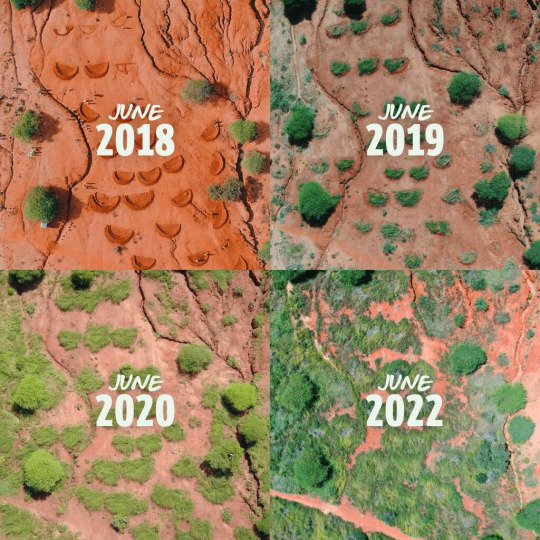
#permaculture#regenerative ag#regenerative agriculture#agriculture#farming#gardening#how to make soil more fertile#how to turn a desert into fertile land#soil#soil fertility#organic farming#organic gardening#water harvesting
3K notes
·
View notes
Text
Every once in a while I’ll see some posts about everyone should become vegan in order to help the environment. And that… sounds kinda rude. I’m sure they don’t mean to come off that way but like, humans are omnivores. Yes there are people who won’t have any animal products be it meat or otherwise either due to personal beliefs or because their body physically cannot handle it, and that’s okay! You don’t have to change your diet to include those products if you don’t want to or you physically can’t.
But there’s indigenous communities that hunt and farm animals sustainably and have been doing so for generations. And these animals are a primary source of food for them. Look to the bison of North America. The settlers nearly caused an extinction as a part of a genocide. Because once the Bison were gone it caused an even sharper decline of the indigenous population. Now thankfully Bison did not go extinct and are actively being shared with other groups across America.
Now if we look outside of indigenous communities we have people who are doing sustainable farming as well as hunting. We have hunting seasons for a reason, mostly because we killed a lot of the predators. As any hunter and they will tell you how bad the deer population can get. (Also America has this whole thing about bird feathers and bird hunting, like it was bad until they laid down some laws. People went absolutely nuts on having feathers be a part of fashion like holy cow.)
We’re slowly getting better with having gardens and vertical farms within cities, and there’s some laws on being able to have a chicken or two at your house or what-have-you in the city for some eggs. (Or maybe some quails since they’re smaller than chickens it’s something that you’d might have to check in your area.) Maybe you would be able to raise some honey bees or rent them out because each honey tastes different from different plants. But ultimately when it comes to meat or cheese? Go to your local farmers. Go to farmers markets, meet with the people there, become friends, go actively check out their farm. See how the animal lives are and if the farmer is willing, talk to them about sustainable agriculture. See what they can change if they’re willing. Support indigenous communities and buy their food and products, especially if you’re close enough that the food won’t spoil on its way to you. (Like imagine living in Texas and you want whale meat from Alaska and you buy it from an indigenous community. I would imagine that would be pretty hard to get.)
Either way everything dies in the end. Do we shame scavengers for eating corpses they found before it could rot and spread disease? Do we shame the animals that hunt other animals to survive? Yes factory farming should no longer exist. So let’s give the animals the best life we can give them. If there’s babies born that the farmer doesn’t want, give them away to someone who wants them as a pet. Or someone who wants to raise them for something else. Not everyone can raise animals for their meat. I know I can’t I would get to emotionally attached. I’d only be able to raise them for their eggs and milk.
Yeah this was pretty much thrown together, and I just wanted to say my thoughts and throw them into the void. If you have some examples of sustainable farming/agriculture, please share them because while I got some stuff I posted from YouTube, I’m still interested to see what stuff I might’ve missed!
#solarpunk#farming#hunting#agriculture#sustainability#sustainable farming#sustainable agriculture#like Rewilding farm land is pretty interesting and trying to replicate an ecosystem with farm animals but also allowing wild animals#to make homes in the rewild farm land is pretty cool#and I have an absolute love for food/garden forests#and hydroponics have shown to be really great for communities in the winter time and they want to have fresh produce#all sorts of cool stuff
947 notes
·
View notes
Text
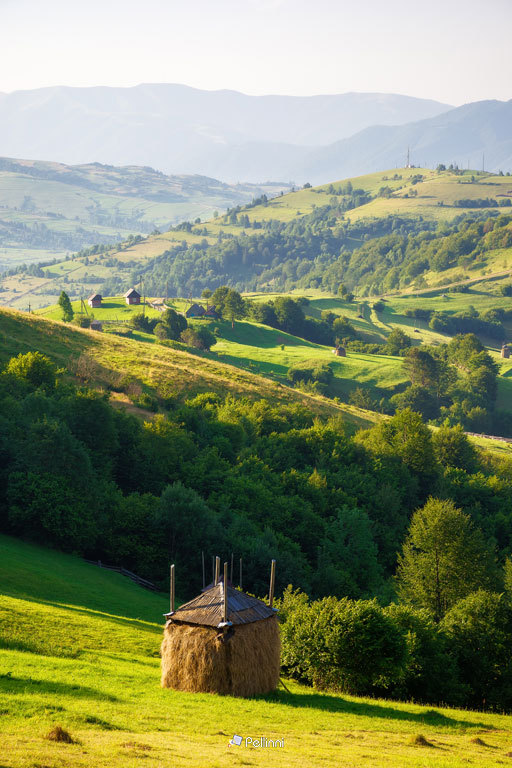
haystack on the grassy hill. mountainous rural landscape of ukraine rolling in to the distance on a sunny morning in summer
#grass#mountain#rural#haystack#hill#field#nature#landscape#summer#green#sky#meadow#countryside#outdoor#land#country#view#tree#beautiful#scenic#agriculture#natural#scenery#season#hay#environment#straw#forest#day#travel
271 notes
·
View notes
Text

Tigran: launching into a story about a time when he was 7 and watched a guy get eaten alive by dogs, completely unprompted and unnervingly blasé about the whole thing.
Etsushir: not listening, warming his hands over the nightly allotment of yams, smoking.
Palo: this is the tenth time he's heard this story, not listening, wondering whether Etsushir is smoking tobacco and where the hell he got it and can he have some?
#Lore:#Tigran has kind of a psychological fixation on people being eaten by dogs. Which is rooted in childhood trauma but it's hard#to tell because he loves dogs and always seems weirdly enthused by the whole concept.#More lore:#They're cooking on a dry dung fire which is very common in the region in general- largely grassland and savannah. Most of the#formerly wooded areas are deforested both on a long scale due to the drying climate and on a short scale of human use.#Wood is a valuable commodity and grown in agricultural regions and harvested with coppicing or otherwise imported by sea.#The northeast has an intact forest that hasn't been widely exploited due to distance from urban centers and impracticality of#transport over land and that's pretty much it.#The Highlands also retain woodlands within the interior but the formerly surrounding forests have been heavily exploited#(due to proximity to major rivers) and were fully wiped out within the past century.#The fact that cremation is the default and expected funerary practice and also used in most sacrificial offerings heavily#contributes (cattle and khait dung is allowable for these purposes due to the animals' sacred status but not considered preferable).#(associated with lower class funerals)#Anyway bottom line dry dung is going to be what the majority of people use for everyday fuel needs and also what pretty#much everyone on the pilgrimage is using (which the wealthier members are unaccommodated to but these guys are)#etsushir#tigran otto#palo apolynnon#the white calf
277 notes
·
View notes
Text
Agricultural Jihad by Issa Al-Laith, celebrating the self-sufficient agriculture reforms under Ansar Allah (2023)
31 notes
·
View notes
Text
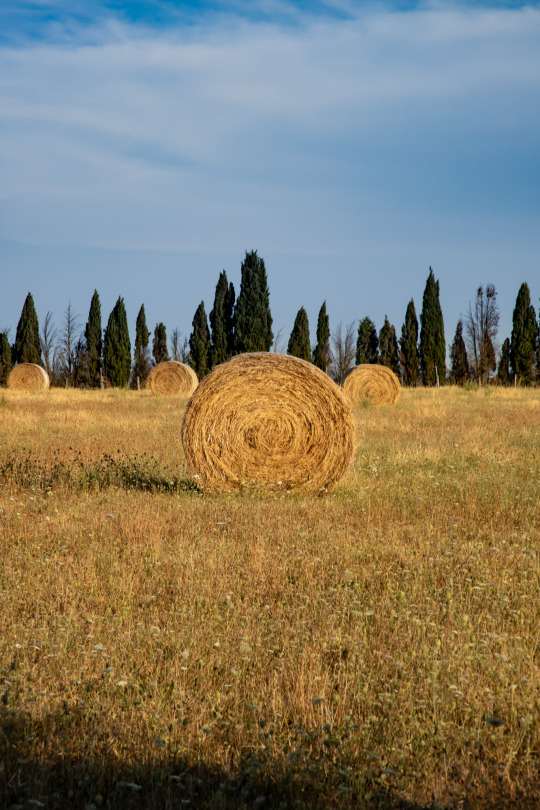
Tournefeuille, paille
Tournefeuille, straw
by sir20 for feuilletourne-sir20
#photographers on tumblr#original photographers#photography#landscape#nature#sir20#feuilletourne-sir20#tournefeuille#photographie#fotografía#fotografia#original photography#artists on tumblr#creators on tumblr#fine art photography#summer#straw#trees#tree#agriculture#farm#haute garonne#occitanie#france#europe#landscape photography#landscapes#land
74 notes
·
View notes
Text
Brazil’s supreme court has blocked efforts to dramatically strip back Indigenous land rights in what activists called a historic victory for the South American country’s original inhabitants.

Indigenous people celebrate the ruling in Brasilia. Photograph: Gustavo Moreno/AP
[…] Similar scenes played out across the Amazon region, which is home to about half of Brazil’s 1.7 million Indigenous citizens.
“[This is a] victory for struggle, a victory for rights, a victory for our history,” the Indigenous congresswoman Célia Xakriabá tweeted. “[All of] Brazil is Indigenous territory and the future is ancestral.”
[…] Casting her vote against a thesis a majority of justices decided was unconstitutional, judge Cármen Lúcia Antunes Rocha said: “We are caring for the ethnic dignity of a people who have been decimated and oppressed during five centuries of history.”
Brazilian society had “an unpayable debt” to the country’s native peoples, Rocha said.
The Indigenous rights group Survival International commemorated the defeat of what it called an attempt “to legalize the theft of huge areas of Indigenous lands”. Dozens of uncontacted tribes could have been wiped out had such efforts prospered, the group claimed.
Source: the guardian
#an anon asked me about this a few months ago#and maybe some of you want good news today#protecting indigenous people protects the Amazon from deforestation by the agricultural sector that proposed this change to strip the land#from the indigenous groups who actually own it
281 notes
·
View notes
Text





#marxism leninism#women's protest#Communist Party of Pakistan#land reform#farmers rights#agriculture#corporate farming#agribusiness#pakistan
29 notes
·
View notes
Text
"The transformation of ancestral lands into intensive monoculture plantations has led to the destruction of Guatemala’s native forests and traditional practices, as well as loss of livelihoods and damage to local health and the environment.
A network of more than 40 Indigenous and local communities and farmer associations are developing agroecology schools across the country to promote the recovery of ancestral practices, educate communities on agroecology and teach them how to build their own local economies.
Based on the traditional “campesino a campesino” (from farmer to farmer) method, the organization says it has improved the livelihoods of 33,000 families who use only organic farming techniques and collectively protect 74,000 hectares (182,858 acres) of forest across Guatemala.
Every Friday at 7:30 a.m., María Isabel Aguilar sells her organic produce in an artisanal market in Totonicapán, a city located in the western highlands of Guatemala. Presented on a handwoven multicolor blanket, her broccoli, cabbage, potatoes and fruits are neatly organized into handmade baskets.
Aguilar is in a cohort of campesinos, or small-scale farmers, who took part in farmer-led agroecology schools in her community. As a way out of the cycle of hunger and poverty, she learned ecological principles of sowing, soil conservation, seed storage, propagation and other agroecological practices that have provided her with greater autonomy, self-sufficiency and improved health.
“We learned how to develop insecticides to fend off pests,” she said. The process, she explained, involves a purely organic cocktail of garlic, chile, horsetail and other weeds and leaves, depending on what type of insecticide is needed. “You want to put this all together and let it settle for several days before applying it, and then the pests won’t come.”
“We also learned how to prepare fertilizer that helps improve the health of our plants,” she added. “Using leaves from trees or medicinal plants we have in our gardens, we apply this to our crops and trees so they give us good fruit.”
The expansion of large-scale agriculture has transformed Guatemala’s ancestral lands into intensive monoculture plantations, leading to the destruction of forests and traditional practices. The use of harmful chemical fertilizers, including glyphosate, which is prohibited in many countries, has destroyed some livelihoods and resulted in serious health and environmental damage.
To combat these trends, organizations across the country have been building a practice called campesino a campesino (from farmer to farmer) to revive the ancient traditions of peasant families in Guatemala. Through the implementation of agroecology schools in communities, they have helped Indigenous and local communities tackle modern-day rural development issues by exchanging wisdom, experiences and resources with other farmers participating in the program.
Keeping ancestral traditions alive
The agroecology schools are organized by a network of more than 40 Indigenous and local communities and farmer associations operating under the Utz Che’ Community Forestry Association. Since 2006, they have spread across several departments, including Totonicapán, Quiché, Quetzaltenango, Sololá and Huehuetenango, representing about 200,000 people — 90% of them Indigenous.
“An important part of this process is the economic autonomy and productive capacity installed in the communities,” said Ilse De León Gramajo, project coordinator at Utz Che’. “How we generate this capacity and knowledge is through the schools and the exchange of experiences that are facilitated by the network.”
Utz Che’, which means “good tree” in the K’iche’ Mayan language, identifies communities in need of support and sends a representative to set up the schools. Around 30-35 people participate in each school, including women and men of all ages. The aim is to facilitate co-learning rather than invite an “expert” to lead the classes.
The purpose of these schools is to help farmers identify problems and opportunities, propose possible solutions and receive technical support that can later be shared with other farmers.
The participants decide what they want to learn. Together, they exchange knowledge and experiment with different solutions to thorny problems. If no one in the class knows how to deal with a certain issue, Utz Che’ will invite someone from another community to come in and teach...
Part of what Utz Che’ does is document ancestral practices to disseminate among schools. Over time, the group has compiled a list of basics that it considers to be fundamental to all the farming communities, most of which respond to the needs and requests that have surfaced in the schools.
Agroecology schools transform lives
Claudia Irene Calderón, based at the University of Wisconsin-Madison, is an expert in agroecology and sustainable food systems in Guatemala. She said she believes the co-creation of knowledge is “key to balance the decision-making power that corporations have, which focus on profit maximization and not on climate change mitigation and adaptation.”
“The recovery and, I would add, revalorization of ancestral practices is essential to diversify fields and diets and to enhance planetary health,” she said. “Recognizing the value of ancestral practices that are rooted in communality and that foster solidarity and mutual aid is instrumental to strengthen the social fabric of Indigenous and small-scale farmers in Guatemala.”
Through the implementation of agroecology schools across the country, Utz Che’ says it has improved the livelihoods of 33,000 families. In total, these farmers also report that they collectively protect 74,000 hectares (182,858 acres) of forest across Guatemala by fighting fires, monitoring illegal logging and practicing reforestation.
In 2022, Utz Che’ surveyed 32 women who had taken part in the agroecology school. All the women had become fully responsible for the production, distribution and commercialization of their products, which was taught to them in agroecology schools. Today, they sell their produce at the artisanal market in Totonicapán.
The findings, which highlight the many ways the schools helped them improve their knowledge, also demonstrate the power and potential of these schools to increase opportunities and strengthen the independence of women producers across the country...
The schools are centered around the idea that people are responsible for protecting their natural resources and, through the revitalization of ancestral practices, can help safeguard the environment and strengthen livelihoods."
-via Mongabay News, July 7, 2023
#a little older but still very good!#indigenous#farming#agriculture#sustainable agriculture#agroecology#land back#guatemala#latin america#north america#central america#indigenous knowledge#indigenous peoples#good news#hope
327 notes
·
View notes
Text

Rural landscape in the south of Germany. Summer in the cornfield.
#field#sky#landscape#wheat#grass#agriculture#nature#summer#meadow#green#blue#farm#cloud#rural#spring#plant#countryside#clouds#harvest#country#horizon#land#tree#season#bavaria#germany
16 notes
·
View notes
